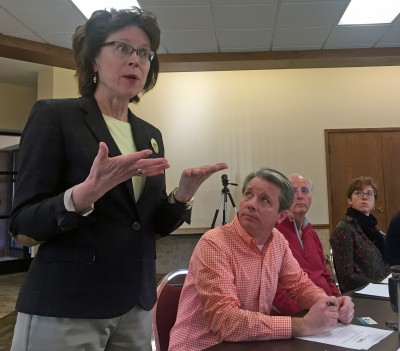Green Meets Green in Equitable Communities and Energy Districts

The Community Foundation of Greater Dubuque has received a grant for $185,000 from The Nathan Cummings Foundation to unite communities in grassroots efforts to provide clean local energy and spark localized energy opportunities. The work will accelerate the growth of energy districts to engage and benefit a diverse range of communities across the Community Foundation’s seven-county service region.
Energy districts facilitate energy planning and coaching for families, businesses and organizations; advocate for clean energy legislation; and promote clean energy programs, such as LED bulb exchanges, home assessments and education. Energy districts are already working in Clayton and Dubuque counties, forming in Allamakee and Delaware Counties, and the new grant will allow the Community Foundation to introduce the concept in Jackson, Jones and Clinton counties. The grant will also enable the formation of a regional network to ensure all community members can participate in and benefit from the district’s work.
“We view the mission of energy districts as a strong companion strategy to our mission of strengthening communities through wealth retention from growing endowments,” said M.J. Smith, director of affiliate foundations at the Community Foundation of Greater Dubuque. The foundation has spent eight months working with energy district enthusiasts in the service region to facilitate the movement and build a case for the grant award.“’Green meets green,’ the energy district tagline, means that individuals, families, businesses and organizations can save money while also stewarding our natural resources. The energy districts will serve income-eligible seniors, veterans and disabled individuals first with energy assessment planning and coaching,” Smith added.
Joleen Jansen, program coordinator for the Clayton County Energy District, has been tagged for the new initiative coordinator role funded by grant dollars. She’ll use the skills she’s honed in Clayton County to coach new energy districts through formation and help them build programming.
“Communities have embraced the beauty of our ‘green meets green’ philosophy. Everyone loves the win-win scenario of emitting less carbon, which is good for the planet, and saving money on a utility bill, which certainly benefits the local economy,” Jansen said.
“Energy districts are working to strengthen communities by facilitating a local, clean and fair energy transformation,” she added. “Energy districts prioritize fair access to energy prosperity. When necessary, energy districts build programs especially for low- to moderate-income earners. Not everyone can afford rooftop solar or a geothermal heating and cooling system, but that doesn't mean they can't save on their utility bill and emit less carbon.”
Unique to Iowa, energy districts are geographically, ideologically and socio-economically inclusive. The local ownership of the institution, the process and the strong positive economic impacts of accelerated, locally-owned clean energy create a shared, community-wide identity. This model has proven its success in driving change and viability for replication.
Andy Johnson, founding director of the Winneshiek Energy District and father of the energy district movement, has actively supported the creation of energy districts in Clayton, Dubuque and Howard counties, with more in the works. Thanks to funding from the Nathan Cummings Foundation, Johnson will coordinate the formation of a regional energy district association to enable and support local energy districts in leading, implementing and accelerating the locally-owned clean, efficient energy transition.
“This movement is important in our region because of the tremendous benefits of ‘green meets green’ – powerful local wealth creation and powerful stewardship,” explained Johnson. “Energy currently is a huge drain on most of our economies across the Midwest. The 21st century world of efficiency and opportunities gives us a chance to keep an ever-growing amount of those energy dollars local to invest in our communities.”